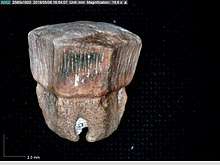Myledaphus
Myledaphus is a genus of Late Cretaceous cartilaginous fish whose fossils are known from Canada, the Midwest of the United States, Olmos Formation of the Difunta Group of Mexico, and the Beshtyubin and Bissekty Formations of Uzbekistan.[2] It was a freshwater guitarfish that probably reached a length of 3 feet (91 cm), and had teeth adapted for a durophagous diet of animals such as clams.[3] Most taxonomic authories place the genus in the Rhinobatidae, with a few placing it with prehistoric sharks (Anacoracidae), although the latter may be incorrect. Two species are known: Myledaphus bipartitus, the type species, and Myledaphus araucanus, named in 2019.
| Myledaphus | |
|---|---|
 | |
| Tooth of M. bipartitus | |
| Scientific classification | |
| Kingdom: | |
| Phylum: | |
| Class: | |
| Order: | |
| Family: | |
| Genus: | †Myledaphus (Cope, 1876) |
| Species: | †M. bipartitus |
| Binomial name | |
| †Myledaphus bipartitus (Cope, 1876) | |
| Species | |
| |
Fossils and age
The most common remains of this fish are teeth and vertebra. A study performed on Myledaphus vertebra from Alberta in 2013 revealed that Myledaphus had an estimated maximum age of 16 years. This means that Myledaphus had a shorter lifespan than that of the modern common guitarfish, by a difference of 8 years.[4]
See also
- List of prehistoric cartilaginous fish
Footnotes
- Rodrigo A. Otero (2019). "Myledaphus araucanus sp. nov. (Batomorphi, Rajiformes incertae sedis), a new Late Cretaceous ray from the austral Pacific, and first occurrence of the genus in the Southern Hemisphere". Cretaceous Research. 100: 82–90. doi:10.1016/j.cretres.2019.03.025.
- "Fossilworks: Myledaphus". fossilworks.org. Retrieved 2016-06-03.
- "Myledaphus bipartitus" (PDF). North Dakota Department of Mineral Resources.
- Wilson, Alycia E.; Newbrey, Michael G.; Brinkman, Donald B.; Cook, Todd D.; Neuman, Andrew G. (2013-06-10). "Age and growth in Myledaphus bipartitus, a Late Cretaceous freshwater guitarfish from Alberta, Canada". Canadian Journal of Earth Sciences. 50 (9): 930–944. doi:10.1139/cjes-2013-0001. ISSN 0008-4077.
References
- Hunt, ReBecca K., Vincent L. Santucci and Jason Kenworthy. 2006. "A preliminary inventory of fossil fish from National Park Service units." in S.G. Lucas, J.A. Spielmann, P.M. Hester, J.P. Kenworthy, and V.L. Santucci (ed.s), Fossils from Federal Lands. New Mexico Museum of Natural History and Science Bulletin 34, pp. 63–69.